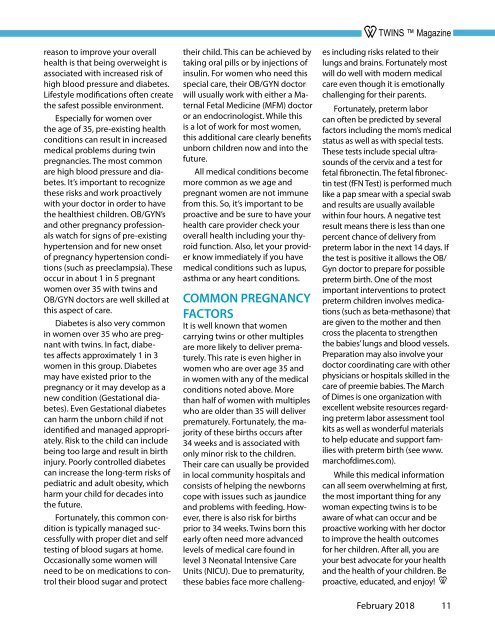TWINS - February 2018
You also want an ePaper? Increase the reach of your titles
YUMPU automatically turns print PDFs into web optimized ePapers that Google loves.
eason to improve your overall<br />
health is that being overweight is<br />
associated with increased risk of<br />
high blood pressure and diabetes.<br />
Lifestyle modifications often create<br />
the safest possible environment.<br />
Especially for women over<br />
the age of 35, pre-existing health<br />
conditions can result in increased<br />
medical problems during twin<br />
pregnancies. The most common<br />
are high blood pressure and diabetes.<br />
It’s important to recognize<br />
these risks and work proactively<br />
with your doctor in order to have<br />
the healthiest children. OB/GYN’s<br />
and other pregnancy professionals<br />
watch for signs of pre-existing<br />
hypertension and for new onset<br />
of pregnancy hypertension conditions<br />
(such as preeclampsia). These<br />
occur in about 1 in 5 pregnant<br />
women over 35 with twins and<br />
OB/GYN doctors are well skilled at<br />
this aspect of care.<br />
Diabetes is also very common<br />
in women over 35 who are pregnant<br />
with twins. In fact, diabetes<br />
affects approximately 1 in 3<br />
women in this group. Diabetes<br />
may have existed prior to the<br />
pregnancy or it may develop as a<br />
new condition (Gestational diabetes).<br />
Even Gestational diabetes<br />
can harm the unborn child if not<br />
identified and managed appropriately.<br />
Risk to the child can include<br />
being too large and result in birth<br />
injury. Poorly controlled diabetes<br />
can increase the long-term risks of<br />
pediatric and adult obesity, which<br />
harm your child for decades into<br />
the future.<br />
Fortunately, this common condition<br />
is typically managed successfully<br />
with proper diet and self<br />
testing of blood sugars at home.<br />
Occasionally some women will<br />
need to be on medications to control<br />
their blood sugar and protect<br />
their child. This can be achieved by<br />
taking oral pills or by injections of<br />
insulin. For women who need this<br />
special care, their OB/GYN doctor<br />
will usually work with either a Maternal<br />
Fetal Medicine (MFM) doctor<br />
or an endocrinologist. While this<br />
is a lot of work for most women,<br />
this additional care clearly benefits<br />
unborn children now and into the<br />
future.<br />
All medical conditions become<br />
more common as we age and<br />
pregnant women are not immune<br />
from this. So, it’s important to be<br />
proactive and be sure to have your<br />
health care provider check your<br />
overall health including your thyroid<br />
function. Also, let your provider<br />
know immediately if you have<br />
medical conditions such as lupus,<br />
asthma or any heart conditions.<br />
A <strong>TWINS</strong> Magazine<br />
COMMON PREGNANCY<br />
FACTORS<br />
It is well known that women<br />
carrying twins or other multiples<br />
are more likely to deliver prematurely.<br />
This rate is even higher in<br />
women who are over age 35 and<br />
in women with any of the medical<br />
conditions noted above. More<br />
than half of women with multiples<br />
who are older than 35 will deliver<br />
prematurely. Fortunately, the majority<br />
of these births occurs after<br />
34 weeks and is associated with<br />
only minor risk to the children.<br />
Their care can usually be provided<br />
in local community hospitals and<br />
consists of helping the newborns<br />
cope with issues such as jaundice<br />
and problems with feeding. However,<br />
there is also risk for births<br />
prior to 34 weeks. Twins born this<br />
early often need more advanced<br />
levels of medical care found in<br />
level 3 Neonatal Intensive Care<br />
Units (NICU). Due to prematurity,<br />
these babies face more challenges<br />
including risks related to their<br />
lungs and brains. Fortunately most<br />
will do well with modern medical<br />
care even though it is emotionally<br />
challenging for their parents.<br />
Fortunately, preterm labor<br />
can often be predicted by several<br />
factors including the mom’s medical<br />
status as well as with special tests.<br />
These tests include special ultrasounds<br />
of the cervix and a test for<br />
fetal fibronectin. The fetal fibronectin<br />
test (fFN Test) is performed much<br />
like a pap smear with a special swab<br />
and results are usually available<br />
within four hours. A negative test<br />
result means there is less than one<br />
percent chance of delivery from<br />
preterm labor in the next 14 days. If<br />
the test is positive it allows the OB/<br />
Gyn doctor to prepare for possible<br />
preterm birth. One of the most<br />
important interventions to protect<br />
preterm children involves medications<br />
(such as beta-methasone) that<br />
are given to the mother and then<br />
cross the placenta to strengthen<br />
the babies’ lungs and blood vessels.<br />
Preparation may also involve your<br />
doctor coordinating care with other<br />
physicians or hospitals skilled in the<br />
care of preemie babies. The March<br />
of Dimes is one organization with<br />
excellent website resources regarding<br />
preterm labor assessment tool<br />
kits as well as wonderful materials<br />
to help educate and support families<br />
with preterm birth (see www.<br />
marchofdimes.com).<br />
While this medical information<br />
can all seem overwhelming at first,<br />
the most important thing for any<br />
woman expecting twins is to be<br />
aware of what can occur and be<br />
proactive working with her doctor<br />
to improve the health outcomes<br />
for her children. After all, you are<br />
your best advocate for your health<br />
and the health of your children. Be<br />
proactive, educated, and enjoy! A<br />
<strong>February</strong> <strong>2018</strong> 11

















